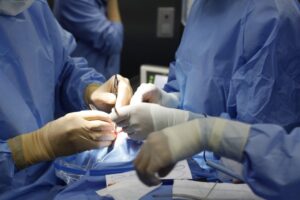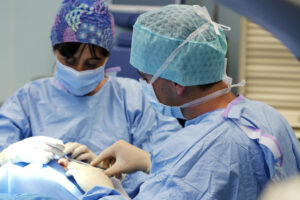Treatments
Watery eye surgery

What does watery eye surgery involve?
Watery eyes may be due to both an excess production of tears and a blockage of the duct through which they are drained. In the latter case, the required solution is surgical, using different techniques that allow us to open a new passage for the tears, allowing their evacuation towards the nose and thus preventing them from accumulating on the eye surface. Thus, not only do we avoid the discomfort associated with continuous tearing, but also the increased risk of periocular infections this entails.
Carrying out a good diagnostic study to determine the exact location of the obstruction is essential to choose the appropriate technique in each case. Any of the structures that make up the tear duct can be affected:
- Lacrimal points: small holes located in the inner corner of the upper and lower eyelids, which collect the tear from the eye surface and divert it towards the canaliculi.
- Canaliculi: small ducts that convey the tear to the lacrimal sac.
- Lacrimal sac: pumps the tear into the nasolacrimal duct.
- Nasolacrimal duct: drains the tear into the nasal cavity for elimination, usually through the nose.
Techniques
Tear duct catheters are the most commonly used procedure for congenital tear duct blockage, whereas dacryocystorhinostomy is the most commonly used technique for watery eye surgery in adults. This surgery acts on the lower ducts (nasolacrimal duct), which is where the passage of the tear is most often blocked.
However, the oculoplastic surgeons at the Miranza clinics are also experts in other less common techniques to treat watery eyes, when the blockage occurs in the upper ducts or canaliculi and dacryocystorhinostomy does not solve excess tearing. In this case, the surgery is more complex, and we usually perform it using Jones tubes, which are thin glass tubes that are permanently placed (instead of using a temporary silicone catheter) and artificially replace the tear duct. On the other hand, when only the lacrimal point is obstructed, we can perform a punctoplasty, i.e. a simple procedure that consists of dilating the point through small incisions or a dilator plug.
Eye diseases treated
Tear duct blockage can be either congenital in children or acquired due to different causes that should be properly diagnosed in adults.
Recovery
Recovery and final prognosis will vary depending on the technique used. In adults, the discomfort gradually disappears during the first two weeks, during which time it is necessary to comply with the postoperative treatment and take into account some basic precautions the surgeon will explain in detail, such as avoiding sudden efforts. You will appreciate the final benefits of the watery eye surgery after a month and a half, approximately.
As for surgery for congenital tear duct blockage, as it is a very mild surgery, it allows for fast recovery of the child, whereas the first results are seen almost immediately.

